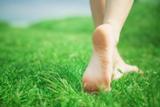
Barefoot running has become a popular topic amongrunners in the last two years. No doubt the attention of barefoot running hasbeen inspired by the popularity of the book Born to Run by ChristopherMcDougal. For decades, there has been a grass-roots movement for extremelyminimalist, i.e., barefoot, running. But only in the past few years havecompanies begun to get in on the act, too. They now offer stripped-down modelsthat do not have the padding and structural elements that characterizeconventional running shoes.
The question is, does barefoot running reallyoffer an advantage over shoes? Bare footers will argue that modern runningshoes promote a heel-first stride that makes a runner more vulnerable to injuries.Other research suggests that heavily cushioned shoes actually prevent your footfrom sensing the ground and can make you stomp down harder than if you didn'thave all that padding.
So, why would you encourage your clients to runbarefoot? The biggest reason barefoot running has become popular is because itclaims to reduce running injuries and improve foot biomechanics. What's theevidence behind this notion? And should a person try it? There isn't strongevidence that barefoot running is any better or worse than running with morestructured shoes, in part because there aren't enough regular barefoot runnerswith whom to compare users of running shoes. But there's a lack of a solidevidence base for running footwear in general.
However, many who have switched over to barefootrunning claim it has reduced or negated their running injuries.
Let's back up and talk about why running injurieshappen in the first place. It has a lot to do with how the foot strikes thepavement when running. An ideal foot strike is one where the mid foot strikesthe ground first and then slowly rolls onto the heel. However, most runnersstrike heel first, which puts a ton of added pressure and impact on the legswhich can lead to a host of running injuries. But, until more research isavailable, it's hard to say if shoes are helpful or harmful. But here are thepros and cons that are often discussed when it comes to barefoot running.
PotentialBenefits of Barefoot Running
Barefoot running helps to correct the foot strikeon the ground, forcing the runner to hit the pavement mid-foot first. Thishelps develop a more natural gait and strengthen the muscles, tendons andligaments of the foot. Furthermore, the foot has a wonderful feedbackmechanism: when you've worked it out enough for one day, it tells you quickly!Your arches will be sore, your foot will be raw from pavement or you'll get thedreaded top-of-the-foot pain. When you run barefoot, your body preciselyengages your vision, your brain, the soles of your feet and all the muscles,bones, tendons and supporting structures of your feet and legs. If you doanything wrong, the foot will tell you. The foot is the great disciplinarian. Youcan't over-pronate, can't overtrain and can't overstride when barefoot running.
So, when wearing shoes, a runner is more likelyto use an undesirable foot strike motion due to the majority of the paddingplaced in the rear of the foot. This causes a runner to more likely strike heelfirst, an undesirable and injury-prone running motion. Furthermore, the argumentis wearing shoes can cause the small muscles in our feet to weaken and thetendons, ligaments and natural arches to stop doing their job. It is believedthat the result of supportive shoe inserts, orthotics and extra cushioning ispoor foot biomechanics and increased risk of foot, leg and knee injuries.
Potential Harms of Barefoot Running
Suddenly going barefoot or wearing a minimal shoecan be quite a shock to the foot and require a slow adaptation phase. But thatisn't the only concern about a shoeless workout.
Shoes offer a significant amount of protectionfrom road debris such as glass, nails, rocks and thorns. They also offerinsulation in cold weather and protect us from frostbite in ice and snow. Mostof us are not used to going barefoot, so a minimalist shoes or bare foot willcause the muscles to initially feel overworked. In some, this can lead toinjuries such as Achilles tendinitis or calf strain. Finally, the bottom of the foot for most people issoft and tender. Going without a stiff-soled shoe may initially cause plantarpain and blisters.
So, togo barefoot or not? It is a very individual thing which some people canbe very successful with, and others cannot. I have coached many who simply cannotmake the transition for one reason or another, and I don't think there is anyreason to force them too. It goes back to the old saying, "If it ain'tbroke, don't fix it!" If you have no problems and no pain, do you reallyneed to change anything?
If you or your clients decide to give barefoot a try, my advice is to startvery slow, expect significant calf strain after even your first day of halfmile or mile. Suddenly going barefoot or wearing a minimal shoe can be quite ashock to the foot and require a slow adaptation phase. Start off slowly andstop if it doesn't feel right, since you are probably used to wearing regularshoes. A great way to learn and adapt your feet is to try it first barefoot ona hard but smooth surface like a tennis court, track or grassy field. Your bodywill quickly tell you what to do. Listen to your body; in the end, the ultimateexperts on footwear are you and your body.
For those of you who want to make the barefoot leap and try it out yourself,check out the below list of barefoot gear. Remember, you don't have to goentirely barefoot. There is a growing list of minimalist running options. Thelist below is ideal for those that want to strip off traditional running shoesbut not go entirely shoeless:
Vibram Five Fingers are the most popular barefoot shoe and are reallystarting to take off amongst the minimalist culture.
Huarache running sandals are also very popular and inspired by tribesmanfrom around the world.
The Nike Free is Nike's response to the barefoot running phenomenon.
 Jill Bruyere has been coaching runners for over 11 years. She is an ACSM certified trainer and coach based in Seattle, Washington. Jill trains clients in her area through her own running business, Run with Jill Bootcamp. She trains clients for all distances of running from the 5k to marathon distance. She created and sells two marathon training programs and has successfully helped many people from all over the world complete a successful marathon race. Her training program and blog can be found online: http://www.runwithjill.com Jill Bruyere has been coaching runners for over 11 years. She is an ACSM certified trainer and coach based in Seattle, Washington. Jill trains clients in her area through her own running business, Run with Jill Bootcamp. She trains clients for all distances of running from the 5k to marathon distance. She created and sells two marathon training programs and has successfully helped many people from all over the world complete a successful marathon race. Her training program and blog can be found online: http://www.runwithjill.com |











